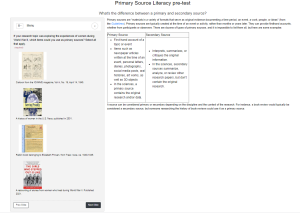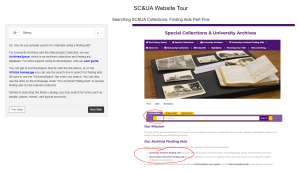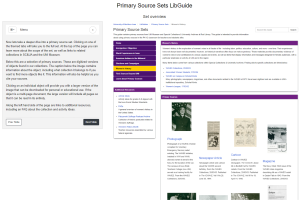Pedagogy
27 One Step Ahead: Asynchronous Tools to Prepare Students for Instruction
Jaycie Vos
Introduction
When introducing higher education students to primary sources, there is great potential and value in providing meaningful interactions with archival collections, but first, students need to understand the basic tenets of primary source literacy (PSL). The archives and broader information literacy literature has established that active learning is an effective, meaningful way for library and archives instructors to engage students with primary sources and other archival materials.[1] Specifically, the literature indicates the flipped classroom model is beneficial when teaching with archives and special collections materials.[2] Additionally, the introduction of the Guidelines for Primary Source Literacy by the SAA-ACRL/RBMS Joint Task Force on the Development of Guidelines for Primary Source Literacy (Guidelines) has given archivists a clear set of learning objectives when teaching with primary sources, or TPS. But while one-shots remain the norm[3] and archivists generally have limited opportunities to engage students, there is rarely time for both building foundational knowledge and meaningful engagement. When time is tight, how do archivists lead active learning sessions if a student is still unsure of the difference between a primary and secondary source? How do archivists know the students’ baseline knowledge in the first place, in order to make the best use of instruction time?
Asynchronous Approach and Tools at UNI
The University of Northern Iowa (UNI)’s library is home to both Special Collections & University Archives (SC&UA) and the UNI Museum, creating a unique opportunity to provide TPS instruction across the curriculum. To maximize instruction time and impact at UNI, an archivist (the author) and a museum professional implemented a flipped classroom approach and worked together to create online, asynchronous tools for students to use ahead of library instruction sessions. These tools serve as both formative assessment and a way to establish foundational PSL knowledge and skills before going into the classroom. Because the library already uses SpringShare products, they chose to create tutorials and quizzes through LibWizard. While specific examples in this chapter use LibWizard, readers could create tutorials and quizzes using a variety of platforms or software; see Asynchronous Tools in PSL Instruction below for examples.
The author developed a pretest and multiple tutorials with built-in quizzes, in which core concepts and learning objectives from the SAA-ACRL/RBMS Guidelines are embedded.
Pretest
The pretest serves two functions: first, it introduces core PSL concepts through brief explanatory text and examples, and second, it assesses students’ existing PSL skills and knowledge through short quizzes. This creates moments for students to practice what they just learned, and it provides instructors with insight about which areas to focus on during the instruction session.
Explanatory text and quiz questions focus on definitions and examples of primary and secondary sources, distinguishing between the two for a given research question or project, and where to find sources in physical or digital environments. The pretest also touches on recognizing and understanding information from both the content and context of a source and how to determine if a source is appropriate for a given project or purpose.

[Document 1: vos_psl_pretest_sample_ocr-2]
Tutorials
Several tutorials navigate the SC&UA and UNI Museum websites, exposing students to finding aids and museum catalogs and eliminating the need for extensive website demos during class. The tutorials provide guidance on searching and browsing strategies, and they introduce common tools for finding primary sources. They also demonstrate how and where to find specific pieces of information, such as a scope and content note, and how to cite sources properly. Quiz questions throughout the tutorials give students a chance to practice these skills to search for and find specific resources and information in the catalog and finding aids.

[Document 2: vos_psl_scua_website_tutorial_sample_ocr]
The final tutorial shows how to navigate online primary source sets in LibGuides, exposing students to a sample of digitized primary sources from SC&UA and the UNI Museum prior to class. It demonstrates how to find the LibGuide and how the LibGuide is organized, and it creates an opportunity for students to begin examining and interacting with the digitized materials. The tutorial also covers where to find additional information about a given source, and how and where to find primary sources at other institutions. Additionally, there are questions built in to assess whether students understand the ideas and functions introduced in the tutorial, such as where to find collection identifiers.

[Document 3: vos_psl_libguide_tutorial_sample_ocr]
Using these tools ahead of time creates more opportunities for meaningful engagement with students during limited instruction time. Students come to instruction sessions—both in-person and virtual—with a basic understanding of PSL concepts and practice searching and finding digitized primary sources online. As a result, the asynchronous tools eliminate the need to dwell on website navigation and basic PSL skills and knowledge in class, and students are prepared with more nuanced questions and are ready to hit the ground running with the planned activities. Additionally, guided by the results of the pretest and tutorial responses, the author is able to selectively demonstrate or emphasize processes or concepts where students may need additional support. For example, the pretest results may suggest students struggle to correctly identify information in a finding aid. Knowing this, the author may devote extra instruction time to reviewing the purpose and components of a finding aid to provide clarity to the students. With so much work completed ahead of time, the author is also able to prioritize hands-on interaction with primary sources much sooner, such as through a think-pair-share activity with physical or digital collections. Therefore, students are able to practice identifying, using, interpreting, analyzing, and evaluating sources during active learning activities with the guidance and support of the author during class time.
Putting this into Practice
Try the following to implement these tools locally:
- Create a pretest to evaluate students’ existing knowledge and skills, and to offer baseline knowledge asynchronously ahead of class time. Pretest questions could center around specific PSL learning objectives as defined in the SAA-ACRL/RBMS Guidelines as well as local practices and collection-specific content, such as testing whether students can correctly find a known item using a finding aid or database. This could also include questions that assess students’ skills and knowledge identified by the course instructor. The pretest is also an opportunity to provide definitions, examples, and demonstrations to students. For example, explanatory text about the difference between primary and secondary sources could be paired with a question where students identify examples of each for a given research question.
- Develop tutorials to expose students to relevant websites and how they function. This could be for whatever is an appropriate starting point for a student, such as an archives’ homepage or content management system. In the tutorial, show how to find the relevant site, demonstrate how to navigate it, where to find key information (such as collections and contact information), and basic tips and tricks for effective searching and browsing. In addition to providing information through text and demonstrations via screen captures or brief videos, include questions that allow students to practice the skills shared in the tutorial. For example, ask students to navigate to a given record group or finding aid. While this tutorial could be very broad, depending on the needs of students and the depth of information that is appropriate for them, it may be helpful to create multiple tutorials for specific systems or to demonstrate complex functions to avoid overwhelming students in a single tutorial.
- Make shorter, more focused tutorials for using specific resources or completing specific or complex tasks. Examples could include:
- browsing an online catalog
- navigating and identifying the components of a finding aid
- making a research appointment and requesting a specific box or item to view in the reading room
- searching an online collection, with specific tasks of downloading and citing an item
- To assess the effectiveness of the tutorials and quizzes and the instruction overall, consider adding a post-test for students to complete after the instruction session.
All of these quizzes and tutorials should be customized to best meet the needs of the students and the readers’ own TPS practice. Emphasize specific knowledge and skills that best support the PSL learning objectives that the reader has identified, consulting the course instructor as necessary. Consider the student population and their abilities, drawing on prior experience in the library classroom to make decisions about which examples and demonstrations will be most engaging and helpful, and whether a specific task or content tutorial is needed. Use this as an opportunity to highlight materials students may otherwise not encounter. These tools should be updated and refreshed often to meet the evolving needs of the students and to account for any process, website, or system changes at a given institution.
Generating buy-in from the course instructor is key for encouraging—or requiring as a part of the coursework—students to complete these quizzes and tutorials. Identify a few invested instructors who routinely integrate TPS in their classrooms, and approach them about sharing these tools with their students ahead of time. Emphasize the formative assessment aspect and how this work ahead of class will improve the instruction experience because students will already understand core concepts, leaving more time and space to dive into hands-on interaction and analysis of primary sources. Consider designing an assignment together with the course instructor where students must find and use a primary source as part of a larger project; for example, education students must integrate a primary source from the university archives into a lesson plan for a social studies lesson. Not only will this make the instruction more significant as the students are directly expected to apply these skills, but offering to collaborate with the course instructor to create a tangible outcome for their class may demonstrate the readers’ investment and support, making it easier to achieve buy-in.
Asynchronous Tools in PSL Instruction
LibWizard is one of many paid authoring tools or interactive learning modules. Other paid tools include Articulate 360, Adobe Captivate, Sidecar Learning, and TechSmith Camtasia, among others. While the specific functionalities vary, such products can be used to create quizzes and forms, tutorials, screen recordings, and interactive presentations.
Free tools are typically less robust and have fewer features, but may still be helpful in developing asynchronous instructional tools. Consider making screen recordings and slides to demonstrate, with visuals, how to navigate a website, search and browse collections, and complete specific tasks, like downloading digitized materials from an online collection. Tools like Screencastify can be used to make screen recording videos, which could be posted to YouTube or shared locally. Slides created with Google Slides or Canva can also be used to share explanatory text and definitions, links or QR codes, still images, and other content to stand alone or accompany a video. SurveyMonkey and Google Forms are free options to make online quizzes to accompany the tutorials for the formative assessment piece. It may be beneficial to package slides, videos, and quizzes together so that students easily understand which content to explore in which order.
In addition to cost, it may be helpful to consider student preferences and needs. For example, it may be important to choose a mobile-friendly tool if students routinely use a smartphone rather than a desktop or laptop to complete assignments.
Additional Assessment Options and Examples
While these tools are used at UNI in part as formative assessment, they could be adapted to meet the assessment and evaluation needs of various institutions. Over the past approximately fifteen years, archivists have increasingly written about archives instruction and PSL assessment; their work could guide new or existing assessment programs. Bahde and Smedberg’s 2012 article “Measuring the Magic: Assessment in the Special Collections and Archives Classroom” provides an early, extensive overview of assessment practices in archives instruction and offers suggestions for implementing formal and informal evaluation technologies and approaches. Prior to the SAA-ACRL/RBMS Guidelines, in 2016, Carini offered standards and outcomes to measure PSL.[4] Since the publication of the Guidelines, multiple archivists and educators have written about putting them into practice and related assessment. For tools and models of such assessment, see Hauck and Robinson (2018), the Teaching with Primary Sources Collective’s “Guidelines for Primary Source Literacy Rubric” (2019), Strom and Walton’s 2020 case study which includes a rubric and survey questions, and Hoyer et al.’s 2022 article detailing an assessment program’s redesign and implementation for TPS.[5]
Final Considerations
These quizzes and tutorials work well for both in-person and virtual instruction. Because they are designed using digital tools, they easily translate to an online environment. If the instruction session itself will be held virtually, consider emphasizing digital collections and other online resources in the tutorials to make the content accessible and relevant.
While designed for use prior to scheduled instruction sessions, these tutorials could exist freely online and therefore be used by other students and library patrons to boost their knowledge and skills in finding and using primary sources on campus and beyond.
References
Bahde, Anne, and Heather Smedberg. “Measuring the Magic: Assessment in the Special Collections and Archives Classroom.” RBM: A Journal of Rare Books, Manuscripts, and Cultural Heritage 13, no. 2 (2012): 152–74. https://doi.org/10.5860/rbm.13.2.380.
Carini, Peter. “Information Literacy for Archives and Special Collections: Defining Outcomes.” portal: Libraries and the Academy 16, no. 1 (2016): 191–206. https://doi.org/10.1353/pla.2016.0006.
Carini, Peter, and Morgan Swan. “Active Learning with Primary Sources.” In Teaching Undergraduates with Archives, edited by Nancy Bartlett, Elizabeth Gadelha, and Cinda Nofziger, 265–68. Ann Arbor, Michigan: Maize Books, 2019. https://doi.org/10.3998/mpub.11499242.
Flynn, Kara. “Archives and Special Collections Instruction for Large Classes.” portal: Libraries and the Academy 21, no. 3 (2021): 573–602. https://doi.org/10.1353/pla.2021.0031.
Hauck, Janet, and Marc Robinson. “Of Primary Importance: Applying the New Literacy Guidelines.” Reference Services Review 46, no. 2 (2018): 217–41. https://doi.org/10.1108/RSR-03-2018-0025.
Hoelscher, Colleen. “One-Shots in Special Collections and Archives: Moving from Gatekeeper to Guide.” College & Research Libraries 83, no. 5 (2022): 848–50. https://doi.org/10.5860/crl.83.5.848.
Hoyer, Jen, Kaitlin H. Holt, John Voiklis, Bennett Attaway, and Rebecca Joy Norlander. “Redesigning Program Assessment for Teaching with Primary Sources: Understanding the Impacts of Our Work.” The American Archivist 85, no. 2 (2022): 443–79. https://doi.org/10.17723/2327-9702-85.2.443.
Knoff, Meredith, and Maureen Cech. “‘It’s Like Holding History in Your Hands’: Using Inquiry-Based Learning in an Interdisciplinary Special Collections Instruction Session.” The Reading Room: A Journal of Special Collections 4, no. 1 (2019): 6–24. https://web.archive.org/web/20230706015108/https://readingroom.lib.buffalo.edu/PDF/ vol4-issue1/its-like-holding-history-in-your-hands.pdf.
Krause, Magia G. “‘It Makes History Alive for Them’: The Role of Archivists and Special Collections Librarians in Instructing Undergraduates.” The Journal of Academic Librarianship 36, no. 5 (2010): 401–11. https://doi.org/10.1016/j.acalib.2010.06.004.
Manley, Elizabeth S., Rien Fertel, Jenny Schwartzberg, and Robert Ticknor. “Teaching in the Archives: Engaging Students and Inverting Historical Methods Classes at The Historic New Orleans Collection.” The History Teacher 53, no. 1 (2019): 67–105. https://www.jstor.org/stable/27058565.
Rockenbach, Barbara. “Archives, Undergraduates, and Inquiry-Based Learning: Case Studies from Yale University Library.” The American Archivist 74, no. 1 (2011): 297–311. http://www.jstor.org/stable/23079010.
SAA-ACRL/RBMS Joint Task Force on the Development of and Guidelines for Primary Source Literacy. Guidelines for Primary Source Literacy (2018). https://www2.archivists.org/sites/all/files/GuidelinesForPrimarySourceLiteracy-June2018.pdf, archived August 8, 2023, at https://web.archive.org/web/20230809010240/https://www2.archivists.org/sites/all/files/GuidelinesForPrimarySourceLiteracy-June2018.pdf.
Strom, Claire, and Rachel Walton. “Engaging History Majors in Intensive Archival Research: Assessing Scaffolded Curricula for Teaching Undergraduates Primary Source Literacy Skills.” Society of American Archivists Case Studies on Teaching with Primary Sources case no. 16 (2020). https://www2.archivists.org/sites/all/files/TWPSCase_16_Engaging_History_Majors.pdf, archived June 21, 2023, at https://web.archive.org/web/20230621094416/https://www2.archivists.org/sites/all/files/TWPSCase_16_Engaging_History_Majors.pdf.
Teaching with Primary Sources Collective, Guidelines for Primary Source Literacy Rubric (2019). https://tpscollective.org/guidelines-toolkit/guidelines-for-primary-source-literacy-rubric/, archived October 1, 2022, at https://web.archive.org/web/20221001172152/https://tpscollective.org/guidelines-toolkit/guidelines-for-primary-source-literacy-rubric/.
Wagner Webster, Jessica. “Demystifying Digital Archives: Undergraduates, Active Learning, and a Path to Outreach.” Journal of Education for Library and Information Science 61, no. 4 (2020): 489–503. doi: 10.3138/jelis.61.4.2019-0049.
Endnotes
[1] Magia G. Krause, “‘It Makes History Alive for Them’: The Role of Archivists and Special Collections Librarians in Instructing Undergraduates,” The Journal of Academic Librarianship 36, no. 5 (2010): 401–11, https://doi.org/10.1016/j.acalib.2010.06.004; Barbara Rockenbach, “Archives, Undergraduates, and Inquiry-Based Learning: Case Studies from Yale University Library,” The American Archivist 74, no. 1 (2011): 297–311, http://www.jstor.org/stable/23079010; Peter Carini and Morgan Swan, “Active Learning with Primary Sources,” in Teaching Undergraduates with Archives, ed. Nancy Bartlett, Elizabeth Gadelha, and Cinda Nofziger (Ann Arbor, Michigan: Maize Books, 2019), 265–68, https://doi.org/10.3998/mpub.11499242; Jessica Wagner Webster, “Demystifying Digital Archives: Undergraduates, Active Learning, and a Path to Outreach,” Journal of Education for Library and Information Science 61, no. 4 (2020): 489–503, doi: 10.3138/jelis.61.4.2019-0049.
[2] Meredith Knoff and Maureen Cech, “‘It’s Like Holding History in Your Hands’: Using Inquiry-Based Learning in an Interdisciplinary Special Collections Instruction Session.” The Reading Room: A Journal of Special Collections 4, no. 1 (2019): 6–24,
https://web.archive.org/web/20230706015108/https://readingroom.lib.buffalo.edu/PDF/ vol4-issue1/its-like-holding-history-in-your-hands.pdf; Elizabeth S. Manley, Rien Fertel, Jenny Schwartzberg, and Robert Ticknor, “Teaching in the Archives: Engaging Students and Inverting Historical Methods Classes at The Historic New Orleans Collection,” The History Teacher 53, no. 1 (2019): 67–105, https://www.jstor.org/stable/27058565; Kara Flynn, “Archives and Special Collections Instruction for Large Classes.” portal: Libraries and the Academy 21, no. 3 (2021): 573–602, https://doi.org/10.1353/pla.2021.0031.
[3] Colleen Hoelscher, “One-Shots in Special Collections and Archives: Moving from Gatekeeper to Guide,” College & Research Libraries 83, no. 5 (2022): 848–50, https://doi.org/10.5860/crl.83.5.848.
[4] Peter Carini,“Information Literacy for Archives and Special Collections: Defining Outcomes,” portal: Libraries and the Academy 16, no. 1 (2016): 191–206, https://doi.org/10.1353/pla.2016.0006.
[5] Janet Hauck and Marc Robinson, “Of Primary Importance: Applying the New Literacy Guidelines,” Reference Services Review 46, no. 2 (2018): 217–41, https://doi.org/10.1108/RSR-03-2018-0025; Teaching with Primary Sources Collective, Guidelines for Primary Source Literacy Rubric (2019), https://web.archive.org/web/20221001172152/https://tpscollective.org/guidelines-toolkit/guidelines-for-primary-source-literacy-rubric/; Claire Strom, and Rachel Walton, “Engaging History Majors in Intensive Archival Research: Assessing Scaffolded Curricula for Teaching Undergraduates Primary Source Literacy Skills,” Society of American Archivists Case Studies on Teaching with Primary Sources case no. 16 (2020), https://web.archive.org/web/20230621094416/https://www2.archivists.org/sites/all/files/TWPSCase_16_Engaging_History_Majors.pdf; Jen Hoyer, Kaitlin H. Holt, John Voiklis, Bennett Attaway, and Rebecca Joy Norlander, “Redesigning Program Assessment for Teaching with Primary Sources: Understanding the Impacts of Our Work,” The American Archivist 85, no. 2 (2022): 443–79, https://doi.org/10.17723/2327-9702-85.2.443.
Media Attributions
- Private: vos_psl_pretest_sample
- Private: vos_psl_scua_website_tutorial_sample
- Private: vos_psl_libguide_tutorial_sample

